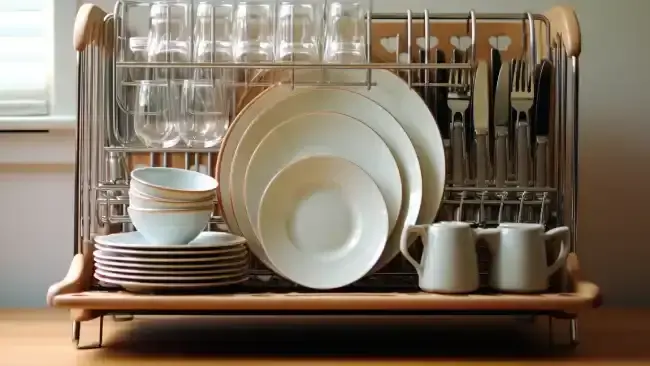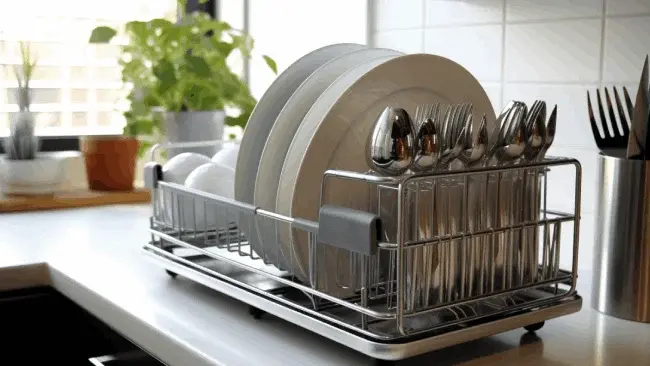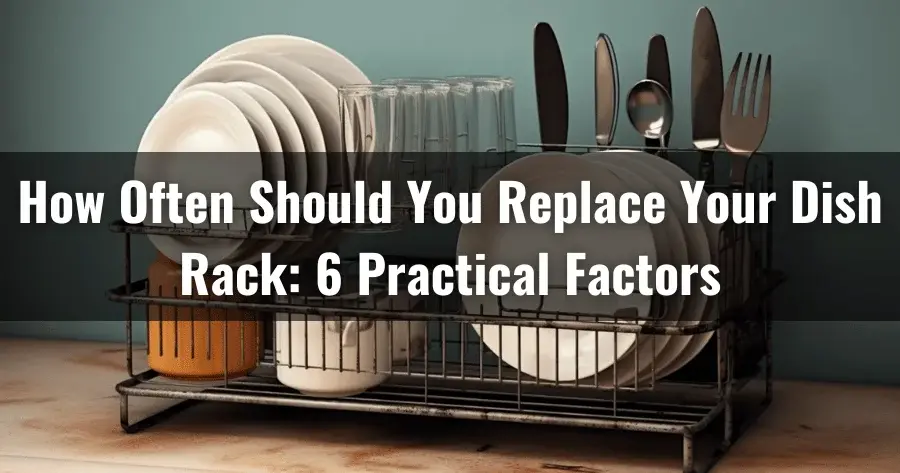The kitchen dish rack, a seemingly simple yet indispensable tool, is a hub for drying, organizing, and storing freshly washed dishes. And like any household item, its lifespan can vary significantly based on various factors.
So, according to our extensive research, we can give you an idea about how often you should replace dish racks.
A low-quality dish rack, susceptible to rapid deterioration, often calls for replacement within a year or two. Meanwhile, a moderate-quality option can endure for 3 to 5 years with vigilant care and maintenance.
At the pinnacle, a high-quality dish rack constructed from robust materials and treated with care can gracefully serve your needs for 5 years or more.
This article will share insight into the factors determining how often you should replace your dish rack. You will also discover some practical tips for extending the life of your kitchen dish rack. So let’s get started.
Jump to Section
How Often Should You Replace Your Dish Rack: Six Factors

When considering how often to replace your dish rack, six key factors exist. Here are the primary considerations.
- Material quality
- Usage frequency
- Load capacity
- Cleaning and maintenance
- Environmental conditions
- Design changes and trends
Let’s break down each factor in more detail.
No 01: Material Quality
The material of the dish rack plays a vital role in determining its longevity. A dish rack made from high-quality materials, such as durable plastics or stainless steel, that is less prone to rust and lasts longer.
A dish rack’s overall construction and build quality are also important. If the dish rack is well-designed and well-constructed, it is more likely to withstand wear and tear for longer. But, if the dish rack is made of low-quality materials, it may need to be replaced more frequently.
No 02: Usage Frequency
The usage frequency of the dish rack is another key factor. If you have a large household and the dish rack is constantly in use, it may experience more wear and tear than a household with fewer occupants. This could result in the dish rack deteriorating faster, especially if the material quality is low.
No 03: Load Capacity
Overloading the dish rack with heavy items can lead to deterioration over time. It might wear out more quickly if you consistently put too much weight on the dish rack. Moreover, if you use a dish rack that is not designed to handle heavy loads, you may need to replace it more often.
No 04: Lack of Cleaning and Maintenance
Lack of regular cleaning and maintenance can ruin the life of your dish rack. Keeping it clean and dry can prevent the buildup of grime, mold, and rust that could otherwise lead to degradation. If you neglect to clean your dish rack often, then you may have to replace it more frequently due to damage caused by build-up.
No 05: Environmental Conditions
The environment in which the dish rack is placed can impact its lifespan.
High humidity, exposure to water, and harsh cleaning agents can all contribute to the degradation of the dish rack. Similarly, if the dish rack is stored in a location where it is constantly exposed to extreme temperatures or sunlight, its lifespan may be shorter than intended.
No 06: Design Changes and Trends
Design trends for kitchen accessories can change over time. If you’re looking to keep up with the latest styles, you might consider replacing your dish rack more frequently.
Also, your personal preferences and how much value you place on having a newer, more modern-looking dish rack can influence when you choose to replace it.
How Can You Prolong the Life of Your Kitchen Dish Rack

To ensure the longevity of your kitchen dish rack, you should keep several key points in mind. The top points are:
- Clean and dry regularly
- Use dish mats or liners
- Separate items
- Avoid overloading
- Inspect for wear and tear
- Use rust prevention measures
- Store properly
Let’s take a closer look at how to maintain your dish rack so it will last longer.
1. Clean and Dry Regularly
Ensure you clean and dry your dish rack regularly to prevent the buildup of food residues, minerals, and grime. Cleaning your dish rack regularly is essential for maintaining its functionality and preventing any potential hygiene issues.
To clean it, use a gentle dish soap and warm water solution. Scrub the rack with a soft brush or sponge to remove dirt or stains. Rinse thoroughly to ensure all soap residue is removed.
After cleaning, dry the rack completely before using it again. Moisture can lead to rusting or other damage, so it’s important to prevent any lingering moisture on the rack.
2. Use Dish Mats or Liners
Depending on your countertop, we suggest placing a dish-drying mat or liner beneath the rack to catch excess water. This simple step can go a long way in maintaining the longevity of your dish rack.
Dish mats and liners are a barrier, preventing water from seeping into your countertop and causing potential issues like mold or warping. They also make cleaning up easier by collecting any drips or spills that may occur during the drying process.
When choosing a mat or liner, opt for one that is absorbent and easy to clean. Look for materials such as microfiber or silicone, which are durable and resistant to mildew.
3. Separate Items
When properly separated, items on the dish rack allow for better air circulation and drainage, reducing the risk of rust or mold growth. Giving each plate, utensil, and cookware its space ensures water can evaporate quickly and easily.
Separating your items also helps to prevent scratching or chipping, as they won’t be rubbing against each other during drying. Leave enough space between each item to avoid touching or overlapping.
We recommend using a dish rack with adjustable dividers or slots to create even more separation options for different dishes.
4. Avoid Overloading
Don’t overload your dish rack with heavy pots, pans, and dishes to prevent warping or breakage. It’s important to consider the weight capacity specified by the manufacturer when loading your dish rack. Overloading it can strain the structure and compromise its durability over time.
When arranging your items on the rack, distribute the weight evenly and avoid placing too many heavy items in one area. If you notice that your dish rack is starting to bend or bow under the weight of your dishes, it’s a clear sign that you are overloading it.
5. Inspect for Wear and Tear
Regularly checking your dish rack for signs of damage is crucial to ensure its proper functioning and prevent any potential accidents.
It is a good idea to check your dish rack carefully for any evidence of rust spots, loose joints, or compromised structural integrity. These issues can weaken the overall stability and effectiveness of your dish rack.
If you notice any problems, promptly address them by cleaning off rust spots, tightening loose joints, or replacing damaged parts.
6. Use Rust Prevention Measures
To prevent rust on your metal dish rack, kitchen experts recommend considering using a light coat of cooking oil or a rust-resistant spray. These preventive measures can help protect your dish rack from moisture and prolong its lifespan.
When applying cooking oil, make sure to use a thin layer and evenly distribute it across the entire surface of the rack. This creates a protective barrier that prevents water molecules from directly contacting the metal and causing rust.
Alternatively, you can opt for a rust-resistant spray specifically designed for metal surfaces. Follow the manufacturer’s instructions for application and reapplication intervals to ensure maximum effectiveness.
7. Store Properly

Ensure the kitchen dish rack is completely dry before storing it in a dry, well-ventilated area to prevent moisture buildup. Storing your dish rack properly will ensure its functionality and durability.
When moisture accumulates on a wet dish rack, it can lead to mold or mildew growth, affecting the cleanliness of your dishes and compromising the structural integrity of the rack itself.
To avoid this issue, take a few extra minutes to thoroughly dry your dish rack before putting it away. Ensure that all surfaces are free from water droplets by using a towel or allowing it to air dry completely.
Conclusion
Now that you know the six factors to consider when determining how often to replace your dish rack, it’s time to implement this knowledge.
You can significantly extend its lifespan by taking proper care of your kitchen dish rack, as mentioned earlier. All things wear out eventually, even with the best maintenance.
So keep a close eye on your dish rack, assess its condition, and don’t hesitate to replace it when necessary. After all, a functional and well-maintained dish rack is essential for an efficient and organized kitchen.





